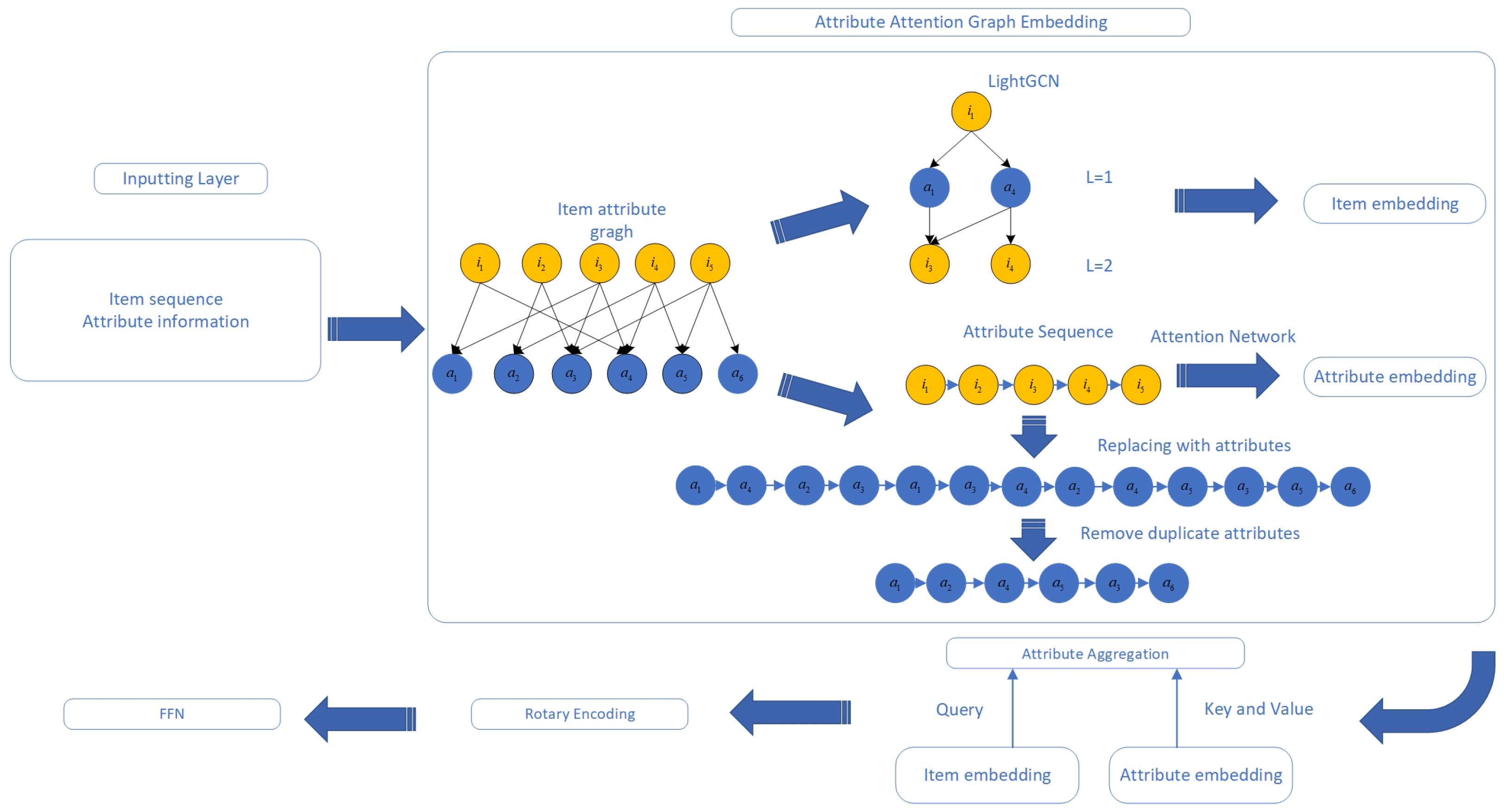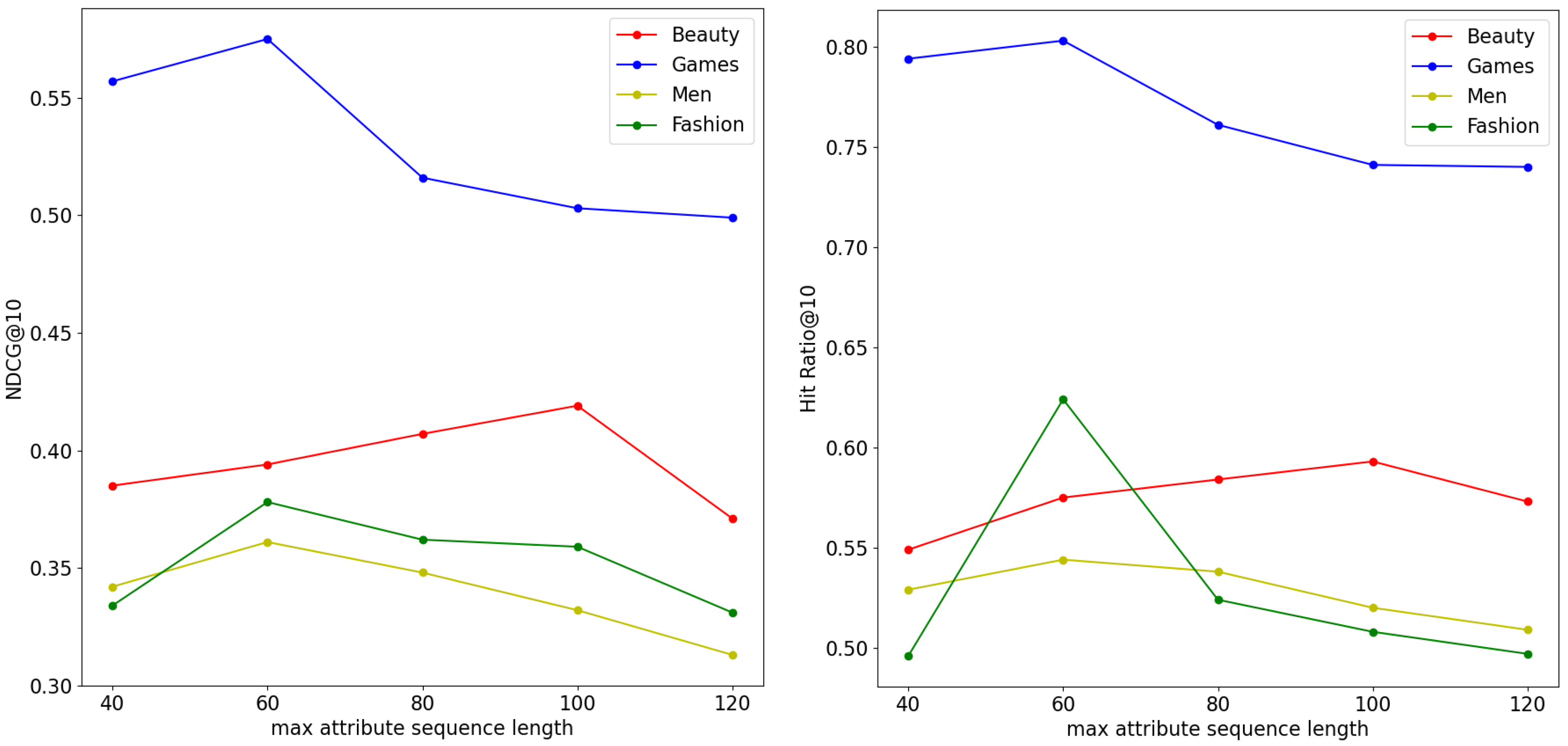Attribute-Aware Graph Aggregation for Sequential Recommendation
Abstract
1. Introduction
- The paper constructs item–attribute interaction graphs to model correlations between attributes and attribute change sequences, to model user preferences for attributes.
- The paper proposes new encoding methods for attention networks, to improve experimental metrics and model stability.
- The paper conducted experiments on four real datasets, and the experimental results show that our proposed model outperformed the state-of-the-art baseline models.
2. Related Work
2.1. Sequential Recommendation
2.2. Attribute-Aware Recommendation
3. Problem Formulation
4. Proposed Model
4.1. Attribute Attention Graph Embedding
4.2. Attribute Aggregation
4.3. Rotary Encoding
4.4. Model Optimization
5. Experimental Setup
5.1. Datasets
5.2. Baselines
5.3. Evaluation Metrics
5.4. Parameter Settings
6. Experimental Results
6.1. Ablation Study
6.2. Hyperparameter Analysis
7. Conclusions
Author Contributions
Funding
Data Availability Statement
Acknowledgments
Conflicts of Interest
References
- Hu, Y.; Koren, Y.; Volinsky, C. Collaborative filtering for implicit feedback datasets. In Proceedings of the 2008 Eighth IEEE International Conference on Data Mining, Pisa, Italy, 15–19 December 2008; pp. 263–272. [Google Scholar]
- Rendle, S. Factorization machines. In Proceedings of the 2010 IEEE International Conference on Data Mining, Sydney, Australia, 13–17 December 2010; pp. 995–1000. [Google Scholar]
- Sarwar, B.; Karypis, G.; Konstan, J.; Riedl, J. Item-based collaborative filtering recommendation algorithms. In Proceedings of the 10th International Conference on World Wide Web, Hong Kong, China, 1–5 May 2001; pp. 285–295. [Google Scholar]
- Wu, L.; Li, S.; Hsieh, C.J.; Sharpnack, J. SSE-PT: Sequential recommendation via personalized transformer. In Proceedings of the 14th ACM Conference on Recommender Systems, Virtual, 22–26 September 2020; pp. 328–337. [Google Scholar]
- Zhou, K.; Wang, H.; Zhao, W.X.; Zhu, Y.; Wang, S.; Zhang, F.; Wang, Z.; Wen, J.R. S3-rec: Self-supervised learning for sequential recommendation with mutual information maximization. In Proceedings of the 29th ACM International Conference on Information & Knowledge Management, Virtual, 19–23 October 2020; pp. 1893–1902. [Google Scholar]
- Kang, W.C.; McAuley, J. Self-attentive sequential recommendation. In Proceedings of the 2018 IEEE International Conference on Data Mining (ICDM), Singapore, 17–20 November 2018; pp. 197–206. [Google Scholar]
- Sun, F.; Liu, J.; Wu, J.; Pei, C.; Lin, X.; Ou, W.; Jiang, P. BERT4Rec: Sequential recommendation with bidirectional encoder representations from transformer. In Proceedings of the 28th ACM International Conference on Information and Knowledge Management, Beijing, China, 3–7 November 2019; pp. 1441–1450. [Google Scholar]
- Hidasi, B.; Karatzoglou, A.; Baltrunas, L.; Tikk, D. Session-based recommendations with recurrent neural networks. arXiv 2015, arXiv:1511.06939. [Google Scholar]
- Hidasi, B.; Karatzoglou, A. Recurrent neural networks with top-k gains for session-based recommendations. In Proceedings of the 27th ACM International Conference on Information and Knowledge Management, Torino, Italy, 22–26 October 2018; pp. 843–852. [Google Scholar]
- Dong, X.; Jin, B.; Zhuo, W.; Li, B.; Xue, T. Improving sequential recommendation with attribute-augmented graph neural networks. In Proceedings of the Pacific-Asia Conference on Knowledge Discovery and Data Mining, Virtual Event, 11–14 May 2021; pp. 373–385. [Google Scholar]
- Rendle, S.; Freudenthaler, C.; Schmidt-Thieme, L. Factorizing personalized markov chains for next-basket recommendation. In Proceedings of the 19th International Conference on World Wide Web, Raleigh, NC, USA, 26–30 April 2010; pp. 811–820. [Google Scholar]
- Zhang, Y.; Dai, H.; Xu, C.; Feng, J.; Wang, T.; Bian, J.; Wang, B.; Liu, T.Y. Sequential click prediction for sponsored search with recurrent neural networks. In Proceedings of the AAAI Conference on Artificial Intelligence, Québec City, QC, Canada, 27–31 July 2014; Volume 28. [Google Scholar]
- Li, J.; Ren, P.; Chen, Z.; Ren, Z.; Lian, T.; Ma, J. Neural attentive session-based recommendation. In Proceedings of the 2017 ACM on Conference on Information and Knowledge Management, Singapore, 6–10 November 2017; pp. 1419–1428. [Google Scholar]
- Vaswani, A.; Shazeer, N.; Parmar, N.; Uszkoreit, J.; Jones, L.; Gomez, A.N.; Kaiser, Ł.; Polosukhin, I. Attention is all you need. In Proceedings of the Advances in Neural Information Processing Systems 30 (NIPS 2017), Long Beach, CA, USA, 4–9 December 2017. [Google Scholar]
- Li, J.; Wang, Y.; McAuley, J. Time interval aware self-attention for sequential recommendation. In Proceedings of the 13th International Conference on Web Search and Data Mining, Houston, TX, USA, 3–7 February 2020; pp. 322–330. [Google Scholar]
- Wang, C.; Zhang, M.; Ma, W.; Liu, Y.; Ma, S. Make it a chorus: Knowledge-and time-aware item modeling for sequential recommendation. In Proceedings of the 43rd International ACM SIGIR Conference on Research and Development in Information Retrieval, Virtual, 24–25 July 2020; pp. 109–118. [Google Scholar]
- Qin, Y.; Ju, W.; Wu, H.; Luo, X.; Zhang, M. Learning graph ode for continuous-time sequential recommendation. IEEE Trans. Knowl. Data Eng. 2024, 36, 3224–3236. [Google Scholar] [CrossRef]
- Pasricha, R.; McAuley, J. Translation-based factorization machines for sequential recommendation. In Proceedings of the 12th ACM Conference on Recommender Systems, Vancouver, BC, Canada, 2–7 October 2018; pp. 63–71. [Google Scholar]
- He, X.; Chua, T.S. Neural factorization machines for sparse predictive analytics. In Proceedings of the 40th International ACM SIGIR Conference on Research and Development in Information Retrieval, Tokyo, Japan, 7–11 August 2017; pp. 355–364. [Google Scholar]
- Shi, S.; Zhang, M.; Liu, Y.; Ma, S. Attention-based adaptive model to unify warm and cold starts recommendation. In Proceedings of the 27th ACM International Conference on Information and Knowledge Management, Torino, Italy, 22–26 October 2018; pp. 127–136. [Google Scholar]
- Zhou, G.; Zhu, X.; Song, C.; Fan, Y.; Zhu, H.; Ma, X.; Yan, Y.; Jin, J.; Li, H.; Gai, K. Deep interest network for click-through rate prediction. In Proceedings of the 24th ACM SIGKDD International Conference on Knowledge Discovery & Data Mining, London, UK, 19–23 August 2018; pp. 1059–1068. [Google Scholar]
- Cheng, H.T.; Koc, L.; Harmsen, J.; Shaked, T.; Chandra, T.; Aradhye, H.; Anderson, G.; Corrado, G.; Chai, W.; Ispir, M.; et al. Wide & deep learning for recommender systems. In Proceedings of the 1st Workshop on Deep Learning for Recommender Systems, Boston, MA, USA, 15 September 2016; pp. 7–10. [Google Scholar]
- Li, T.; Ma, Y.; Xu, J.; Stenger, B.; Liu, C.; Hirate, Y. Deep heterogeneous autoencoders for collaborative filtering. In Proceedings of the 2018 IEEE International Conference on Data Mining (ICDM), Singapore, 17–20 November 2018; pp. 1164–1169. [Google Scholar]
- Su, Y.; Erfani, S.M.; Zhang, R. MMF: Attribute interpretable collaborative filtering. In Proceedings of the 2019 International Joint Conference on Neural Networks (IJCNN), Budapest, Hungary, 14–19 July 2019; pp. 1–8. [Google Scholar]
- Lv, F.; Jin, T.; Yu, C.; Sun, F.; Lin, Q.; Yang, K.; Ng, W. SDM: Sequential deep matching model for online large-scale recommender system. In Proceedings of the 28th ACM International Conference on Information and Knowledge Management, Beijing, China, 3–7 November 2019; pp. 2635–2643. [Google Scholar]
- Zhang, T.; Zhao, P.; Liu, Y.; Sheng, V.S.; Xu, J.; Wang, D.; Liu, G.; Zhou, X. Feature-level deeper self-attention network for sequential recommendation. In Proceedings of the IJCAI, Macao, China, 10–16 August 2019; pp. 4320–4326. [Google Scholar]
- Rashed, A.; Elsayed, S.; Schmidt-Thieme, L. Context and attribute-aware sequential recommendation via cross-attention. In Proceedings of the 16th ACM Conference on Recommender Systems, Seattle, WA, USA, 18–23 September 2022; pp. 71–80. [Google Scholar]
- He, X.; Deng, K.; Wang, X.; Li, Y.; Zhang, Y.; Wang, M. Lightgcn: Simplifying and powering graph convolution network for recommendation. In Proceedings of the 43rd International ACM SIGIR Conference on Research and Development in Information Retrieval, Virtual, 24–25 July 2020; pp. 639–648. [Google Scholar]
- Ding, Q.; Sun, T.; Zhou, M. Attribute-driven Interest Modeling for Sequential Recommendation. In Proceedings of the 2022 International Joint Conference on Neural Networks (IJCNN), Padua, Italy, 18–23 July 2022; pp. 1–8. [Google Scholar]
- Su, J.; Ahmed, M.; Lu, Y.; Pan, S.; Bo, W.; Liu, Y. Roformer: Enhanced transformer with rotary position embedding. Neurocomputing 2024, 568, 127063. [Google Scholar] [CrossRef]
- Lopez-Avila, A.; Du, J.; Shimary, A.; Li, Z. Positional encoding is not the same as context: A study on positional encoding for Sequential recommendation. arXiv 2024, arXiv:2405.10436. [Google Scholar]
- He, R.; McAuley, J. VBPR: Visual bayesian personalized ranking from implicit feedback. In Proceedings of the AAAI Conference on Artificial Intelligencer, Phoenix, AZ, USA, 12–17 February 2016; Volume 30. [Google Scholar]
- Hou, M.; Wu, L.; Chen, E.; Li, Z.; Zheng, V.W.; Liu, Q. Explainable fashion recommendation: A semantic attribute region guided approach. arXiv 2019, arXiv:1905.12862. [Google Scholar]
- Steck, H. Embarrassingly shallow autoencoders for sparse data. In Proceedings of the The World Wide Web Conference, San Francisco, CA, USA, 13–17 May 2019; pp. 3251–3257. [Google Scholar]




| Datasets | User | Item | Interactions | Attributes | Sparsity |
|---|---|---|---|---|---|
| Beauty | 52,204 | 57,289 | 394,908 | 6507 | 99.9868% |
| Video games | 31,013 | 23,715 | 287,107 | 506 | 99.9610% |
| Men | 34,244 | 110,636 | 254,870 | 2048 | 99.9933% |
| Fashion | 451,84 | 166,270 | 358,003 | 2048 | 99.9523% |
| Parameter | Beauty | Video Games | Men | Fashion |
|---|---|---|---|---|
| Learning Rate | 0.0001 | 0.0001 | 0.000006 | 0.00001 |
| Max Sequence Length | 75 | 50 | 35 | 35 |
| Dropout Rate | 0.5 | 0.5 | 0.3 | 0.3 |
| Embedding Dimension | 90 | 90 | 390 | 390 |
| Dimension of Fully Connected Layer | 450 | 450 | 1950 | 1950 |
| Maximum Length of Attribute Sequence | 100 | 80 | 60 | 60 |
| Model | Beauty | Video Games | Men | Fashion | ||||
|---|---|---|---|---|---|---|---|---|
| NDCG@10 | HitRatio@10 | NDCG@10 | HitRatio@10 | NDCG@10 | HitRatio@10 | NDCG@10 | HitRatio@10 | |
| SASRec | 0.322 | 0.485 | 0.541 | 0.742 | 0.259 | 0.397 | 0.245 | 0.381 |
| BERT4Rec | 0.318 | 0.478 | 0.509 | 0.705 | 0.193 | 0.315 | 0.309 | 0.328 |
| S3Rec | 0.371 | 0.538 | 0.541 | 0.765 | 0.238 | 0.365 | 0.239 | 0.367 |
| CARCA | 0.394 | 0.574 | 0.567 | 0.775 | 0.349 | 0.550 | 0.381 | 0.591 |
| Ours | 0.419 | 0.593 | 0.575 | 0.803 | 0.361 | 0.544 | 0.378 | 0.624 |
| Model | Beauty | Video Games | Men | Fashion | ||||
|---|---|---|---|---|---|---|---|---|
| NDCG@10 | HitRatio@10 | NDCG@10 | HitRatio@10 | NDCG@10 | HitRatio@10 | NDCG@10 | HitRatio@10 | |
| w/o attr agg. | 0.385 | 0.575 | 0.548 | 0.789 | 0.355 | 0.519 | 0.331 | 0.497 |
| w/o attr seq. | 0.371 | 0.549 | 0.527 | 0.781 | 0.359 | 0.519 | 0.346 | 0.508 |
| Ours | 0.419 | 0.593 | 0.575 | 0.803 | 0.361 | 0.544 | 0.378 | 0.624 |
Disclaimer/Publisher’s Note: The statements, opinions and data contained in all publications are solely those of the individual author(s) and contributor(s) and not of MDPI and/or the editor(s). MDPI and/or the editor(s) disclaim responsibility for any injury to people or property resulting from any ideas, methods, instructions or products referred to in the content. |
© 2025 by the authors. Licensee MDPI, Basel, Switzerland. This article is an open access article distributed under the terms and conditions of the Creative Commons Attribution (CC BY) license (https://creativecommons.org/licenses/by/4.0/).
Share and Cite
Qu, Y.; Fang, Y.; Tan, Z.; Xiao, W. Attribute-Aware Graph Aggregation for Sequential Recommendation. Mathematics 2025, 13, 1386. https://doi.org/10.3390/math13091386
Qu Y, Fang Y, Tan Z, Xiao W. Attribute-Aware Graph Aggregation for Sequential Recommendation. Mathematics. 2025; 13(9):1386. https://doi.org/10.3390/math13091386
Chicago/Turabian StyleQu, Yiming, Yang Fang, Zhen Tan, and Weidong Xiao. 2025. "Attribute-Aware Graph Aggregation for Sequential Recommendation" Mathematics 13, no. 9: 1386. https://doi.org/10.3390/math13091386
APA StyleQu, Y., Fang, Y., Tan, Z., & Xiao, W. (2025). Attribute-Aware Graph Aggregation for Sequential Recommendation. Mathematics, 13(9), 1386. https://doi.org/10.3390/math13091386






